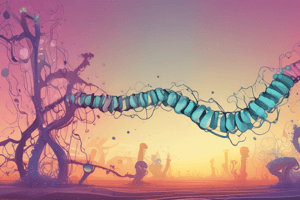Podcast
Questions and Answers
In which direction does DNA polymerase synthesize DNA?
In which direction does DNA polymerase synthesize DNA?
- 5'-2' direction
- 3'-2' direction
- 5'-3' direction (correct)
- 3'-5' direction
What is the role of complementary base pairing in DNA synthesis?
What is the role of complementary base pairing in DNA synthesis?
- It helps in the regulation of gene expression.
- It prevents the loss of genetic material.
- It stabilizes the RNA structure during transcription.
- It determines the sequence of nucleotides added. (correct)
Which component serves as substrates for DNA polymerase during DNA synthesis?
Which component serves as substrates for DNA polymerase during DNA synthesis?
- Amino acids
- Deoxyribonucleotides (dNTPs) (correct)
- Nucleic acids
- Ribonucleotides (rNTPs)
Which enzyme catalyzes the addition of nucleotides to a growing DNA strand?
Which enzyme catalyzes the addition of nucleotides to a growing DNA strand?
What is added to the growing DNA strand during replication?
What is added to the growing DNA strand during replication?
Flashcards are hidden until you start studying
Study Notes
DNA Polymerase and DNA Synthesis
- DNA polymerase (DNA Pol) is an enzyme responsible for adding nucleotides to the 3' end of a growing DNA strand.
- Nucleotides are added in a 5' to 3' direction, meaning the new nucleotide is added to the free 3'-hydroxyl group of the previous nucleotide.
- The substrates used for DNA synthesis are deoxyribonucleoside triphosphates (dNTPs), which are composed of a deoxyribose sugar, a phosphate group, and a nitrogenous base.
- DNA Pol adds nucleotides based on complementary base pairing with the template strand, ensuring accurate replication of the genetic code.
- This process involves hydrogen bonding between complementary base pairs (A with T, and G with C).
Studying That Suits You
Use AI to generate personalized quizzes and flashcards to suit your learning preferences.




